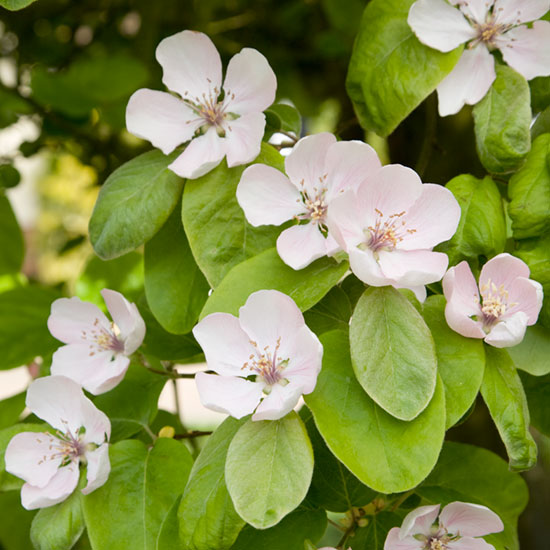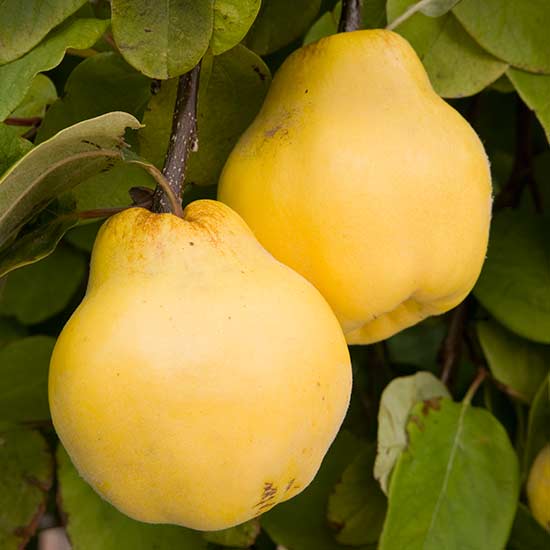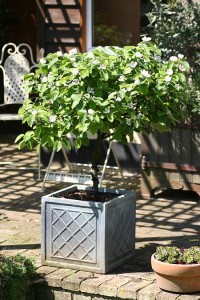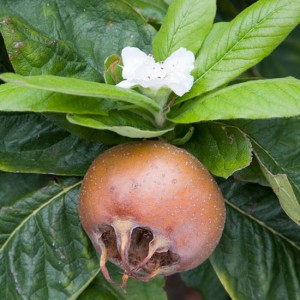Quince are one of those fruits which are fairly well known yet not often grown in the garden – possibly because they are not actually fit for eating raw unless your palate is non-existent, as they are extremely bitter and astringent. I contend that quince are well worth growing in the garden but before we go any further I must clear up the difference between the ornamental quince and the quince grown for its fruits.
The ornamental shrub chaenomeles often known as ‘japonica’ has red, white or orange flowers, is thorny – often spiteful – and produces small, often speckled fruits. This is known as the ornamental quince and is grown for the decorative value of its flowers and its fruits. Sorry but I find this shrub to be of little value in the garden other than to act as a deterrent for would be intruders! It is Cydonia oblonga that we are interested in and this produces hard, often pear shaped, large fruits after large white or pink flowers.
The flowers of Cydonia oblonga are large, white or pink and are often quite spectacular. At flowering time the whole tree can be absolutely covered with blossom which can make it a very useful decorative feature. The fruits are ready for picking from late October and whilst they are not suitable for eating raw they can be put to a good number of uses. So if not suitable for eating raw, what uses do quince fruits have?
As the fruits have a very strong scent and flavour – the variety Vranja probably having the strongest – they can be used for adding flavour to apple pies in particular. I have heard of pies and flans being made entirely of quince – the very astringent flavour being diminished during the cooking – but I have no experience of this. This could be well worth a try for the brave! I have also heard that quince wine is highly desirable (and well appreciated by the Victorians) but again I have not experimented. I do, however, have experience of quince jelly and quince marmalade and I find both of these to be absolutely delicious and thoroughly recommend that you try both even if you do not grow your own quince.
Apart from being edible, quince do have another use and one which has been much prized in the past and this, believe it or not, was as an early air freshener! Recent research has shown that the Mesopotamians and the Romans both used the quince to freshen and sweeten the air in their buildings. You might like to experiment yourself during the autumn and winter! However, it is important to recognize that the smell of the quince is very pervasive and you will be wise to store them away from other fruit or they can become tainted with the aroma – not necessarily what you want if you have been looking forward to a particularly juicy pear!
In the eyes of the ancient Greeks and the Romans the fruit was regarded as an emblem of happiness, love and fruitfulness and they were eaten by newly married couples before they retired to their marriage bed. In Croatia when a baby is born a quince tree is planted as a symbol of fertility, love and life.
Now that you are hopefully intrigued by the quince I will set out to explain how they are best cultivated in the garden. As the trees have a weeping habit they make an attractive feature particularly at flowering time and at fruiting time, especially if the leaves fall early leaving the fruits exposed on the tree. To do this they are probably best grown as half standards although they can be grown as espaliers fairly easily. Incidentally I am never too bothered by birds or squirrels attacking the quince fruits as they seem equally unattractive in their raw state to birds and animals as to humans!
As far as rootstocks are concerned quinces are best grown on the rootstock Quince ‘A’ although the new EMH rootstock, which has recently been developed for pears, may prove very suitable and slightly more dwarfing.
Surprisingly there are a number of quince varieties available and there are five, perhaps, that are well worth trying plus one that can be grown in pots or containers. The good news is that they are all self-fertile which means that you only need to grow one tree.
Champion is an American variety and will produce very large fruits indeed – ideal for the show bench and pure decoration as well. This variety tends to be more apple shaped although it can on occasion resemble a fat pear. Colourwise it will range from a greenish yellow to golden yellow.
Meeches Prolific is American in origin having been named after an amateur pomologist and an authority on the quince. The fruits are pear shaped, quite large in size and golden yellowish in colour. It is a regular and heavy cropping variety and will often start fruiting early in its life. A bonus is that it is a very hardy variety and should suit all parts of the country. For exhibitors this is an excellent show bench variety and probably my favourite.
Portugal is a variety best suited to warmer areas although it will succeed in colder areas grown as an espalier against a warm wall. The fruits, which are yellow orange when ripe, are ovalish in shape and can grow quite large if thinned well. This variety is often considered to have the best flavour for jelly, marmalade and general cooking and its flesh turns red when cooked. This variety is a vigorous grower and will need regular pruning to ensure that it stays a reasonable size and shape.
Serbian Gold (Leskovac) is a very hardy quince of Serbian origin which is very heavy cropping and unusually the fruits are apple shaped rather than pear shaped. This is a less vigorous growing variety of quince but nevertheless a highly productive variety used in its native Serbia for both cooking and making quince liqueur. Besides its fruiting qualities, it has ornamental value, with masses of attractive pink flowers in early spring. The tree is very disease resistant.
Sibley’s Patio Quince is very suitable for growing in a pot and despite its dwarf growing habit will produce a good crop. This naturally dwarf quince is grafted onto a dwarfing rootstock, making it an ideal patio plant. You should expect around 50 fruits per bush after 3 years.
Vranja is an old Serbian variety which produces good quality, very large, pear shaped fruits which are golden yellow when ripe. This variety has, perhaps, the best scent for both flavouring and air sweetening and it is one of the easiest to grow. It comes into bearing early in life, is a regular cropper and is hardy enough to grow anywhere in the country. It is also an ideal show bench variety.
I have found that growing quince is well worth the effort both as a good decorative tree and for the fruits which seem to have many uses in the house. All I know is that all the fruits that I produce are quickly snapped up by my wife, friends and neighbours!
Medlars were once commonly grown in many parts of the British Isles – often in kitchen gardens along with quinces, mulberries and other fruits less commonly grown today. Occasionally medlars can still be found growing in hedgerows, particularly in southern England, often as gnarled old specimens as they are slow growing and long lived.
Medlars have almost developed a mystique because they are relatively peculiar to look at – so much so that a good number are once again becoming planted in gardens. Fortunately, as noted earlier, they are relatively slow growing and it will take a good number of years for them to grow into large trees although they can be easily kept at a small size by regular pruning. They begin to fruit at an early stage often only a couple of years after planting which can be a bonus in the garden situation. They can be very long lived and there is a medlar tree near where I live reputed to be over 200 years old!
Apart from producing fruit, the medlar with its large white or pinkish blossom, makes a very attractive tree and on this basis alone can earn its place in the garden. Incidentally, the medlar is related to the hawthorn, crab apple and pear as part of the Roseacae family – hence the wonderful flowers.
The species Mespilus germanica is often thought of as indigenous to Britain but this is not the case. It is most likely to have originated in Greece or Iran from where it spread to south-east Europe. Although there are few records of its earliest cultivation in Britain it is known to have been around in the sixteenth century; however, it is more than likely that it was brought over here by the Romans.
Currently the medlar is making something of a comeback mainly, I suspect, as an interest in old variety of fruits in increasing – its attractiveness in the spring being a bonus. There are three cultivars generally available today with, perhaps, the most common being Nottingham. All of the medlars listed are self-fertile so do not require a pollinator.
Nottingham is considered to be the best flavoured medlar producing medium sized fruits. It makes a fairly small tree with a weeping habit and it can easily be kept under control. It fruits very well and comes into bearing at a very early age. The flowers are very large and are quite spectacular at flowering time.
Royal produces smaller fruits and is considered to be second in flavour to Nottingham. However, the difference with this variety is that it produces a more ‘natural’ looking tree which can make a very attractive standard.
Westerveldt produces regular crops of large round fruits often well over 5cm (2 inches) in diameter. The flowers are large and white. Like Nottingham it has a compact habit and comes into bearing early on. The flavour and texture however is not as good as Nottingham for eating fresh.
Sibley’s Patio Medlar, as the name suggests, is very suitable for growing in a pot. It produces a very compact bush capable of producing around 30 medlars per bush after 3 to 4 years.
Medlar fruits are harvested in late October or early November preferably on a dry day. They need to be kept until they become soft and ready for use. They should be stored calyx down in single layers, if possible on a medium such as sawdust which will keep them as dry as possible. After two or three weeks of such storage they will become mellow and soft, almost to the extent of breaking down. This process is known as ‘bletting’.
Not everyone enjoys medlars. Indeed I have found that their flavour which is best described as ‘distinctive, pleasantly acid with perhaps a suggestion of astringency’ is either thoroughly enjoyed or thoroughly disliked although I suggest that the latter is more allied to the almost decaying nature of the bletted fruit. Nevertheless I never have any problem of disposing of any of my medlars – there always seems to be a queue of aficionados!
Medlars can either be eaten with a good red wine or port with some cheese or used to make a delicious jelly, which is excellent for accompanying lamb or game. However, if a jelly is to be made the fruits should be prepared before they start going too soft. The flavour of the resulting jelly is most interesting – it was only very recently that it was described to me as tasting of toffee apples!
Medlars are easily grown. They are not particularly fussy about their planting conditions although a free draining soil probably suits them best. Pruning is rarely required due to their slow growing nature, other than removing diseased or dead wood and keeping them to the required shape and height. You can even grow dwarf varieties in pots and containers.
Although medlars may not turn out to be your favourite fruit I thoroughly recommend that you have a go at growing at least one tree, if only to help restore some fruit growing history. At least you can use them as a talking point in your garden and explain why the French have such a rude name for the fruits!
Gerry Edwards
19th October 2014
Gerry is an experienced amateur fruit grower who is Chairman of the RHS Fruit Group, a member of the Royal Horticultural Society’s Fruit, Vegetable and Herb Committee and also their Fruit Trials Panel. Gerry judges fruit nationally for the Royal Horticultural Society and is also a qualified National Vegetable Society judge.





Hi,
I have a quince tree (Vranja) in my garden. I planted it about 5 years ago. However,for the last two seasons the tree has flowered as usual but as the fruit formed the leaves turned black and dropped off. I have tried gathering up the leaves and burning them but to no avail. Is it worth keeping the tree?
Hi Joe
Quince trees are generally relatively free of pests and diseases, though they do prefer hot sunny conditions through summer to thrive. That said, they do normally grow satisfactorily in England, and I am aware of no serious disease that would pose any significant threat to the tree.
They are susceptible to leaf spotting – quince leaf blight, a fungal disease similar to scab, which if severe can reduce vigour and affect cropping. In a bad year, such as 2012, this can leave the trees almost leafless by late summer. However I doubt that is the problem here, this issue is arising far too early in the year.
Pears and quinces do show blackening of their early leaves in spring if they experience cold temperatures, especially overnight (late frosts), made worse if there are also periods of cold driving rain. These symptoms are often made more severe if the plant faces or is open to the east. Covering with fleece overnight if late frost is forecast may help avoid the worst of this.
Is it possible that this problem actually stems from below ground? Not knowing where in the country this tree is planted, its aspect, nor anything about the local soil makes it impossible to be at all sure, but if a tree is not thriving having been in situ for 5 years this has to be a possibility.
Is the pH high enough (ideally 6-7.5)?
Is the drainage satisfactory?
Might there be a compaction layer a foot or two down?
What depth of top soil is there?
Are nutrient levels OK?
Do please come back with answers to any of the questions above, and with any further information you might think is relevant.
I planted a Medlar stone in my garden after tasting the fruit given by a friend. This was over 15 years ago. The stone produced a young tree which I tended lovingly, and grew and grew until it was approximately 15/20 ft high. In all those years it flourished, and I waited patiently for fruit to appear, plenty of leaves and little flowers but NOT ONE fruit. I open my garden for charities and the Medlar always fascinated the visitors and I explained to them, my love of the fruit, but, although a beautiful tree
,I could not produce fruit….. Eventually I had to dispose of it, to my sadness as I needed to use the area for other purposes. My query is:- what did I do wrong?
I don’t think you have done anything wrong. There is never any guarantee that any fruit tree grown from a seed or pip will produce good fruit. You may be lucky – many of our well known varieties of apple such as Cox’s Orange Pippin and Bramley’s Seedling originally arose as chance seedlings, but it is much more likely to revert towards the original species (so towards crab apple where apples are concerned), and occasionally may be “blind”, producing no fruit at all.
It may be the case you have been extremely unlucky and grown an infertile tree that still produces flowers. If it grew and flowered well then clearly your soil is OK, so I would be confident that were you to plant a grafted named variety such as Nottingham it would produce flowers and fruit within a couple of years – provided it gets plenty of sunshine.
Hello there,
My two year old Medlar tree (Nottingham) is currently full of ripening fruit. It is also covered in new blossom! Is this usual for this variety or has it come about because of the very mild Autumn this year? I live in the South Cotswolds near Tetbury.
Hi Graham. This is due to a warm autumn temperatures after a cold spell at the end of the summer. The tree behaves as if it has been through a mild winter and spring has arrived. The blossom will get frosted but it shouldn’t make much difference to next years crop.